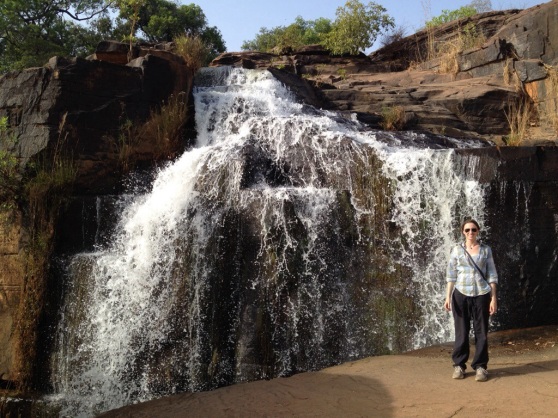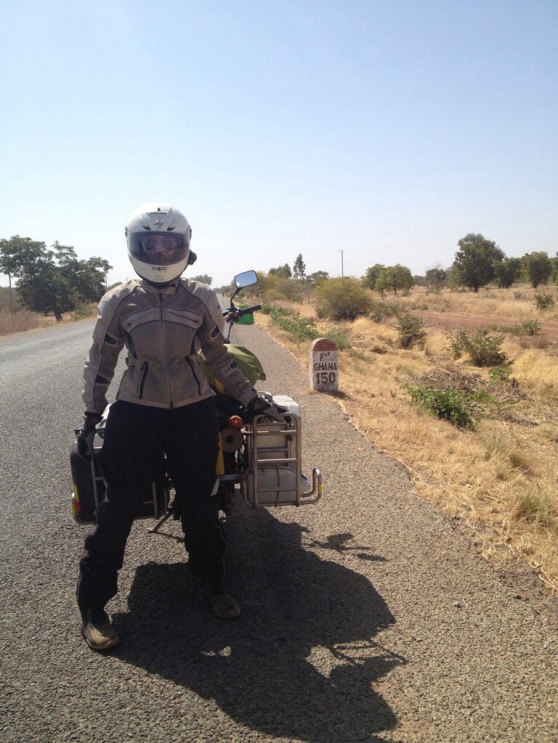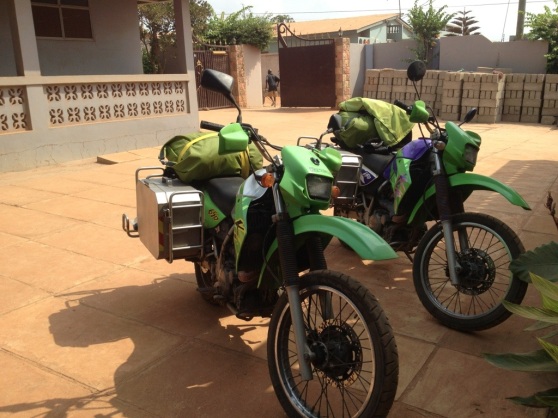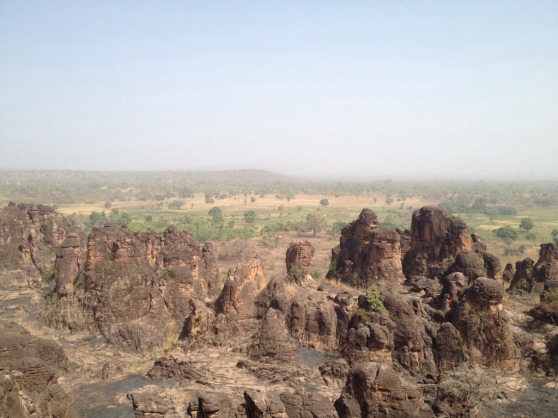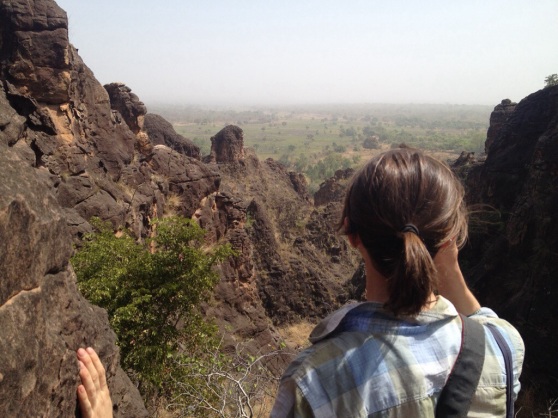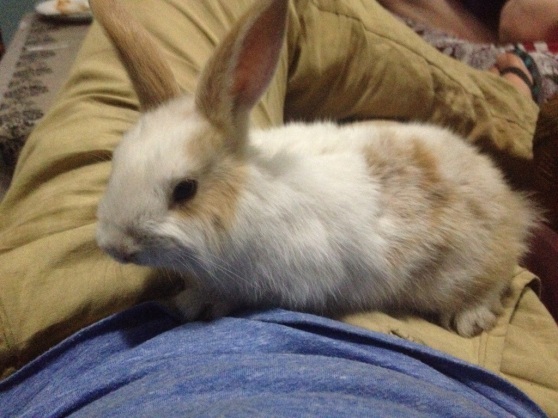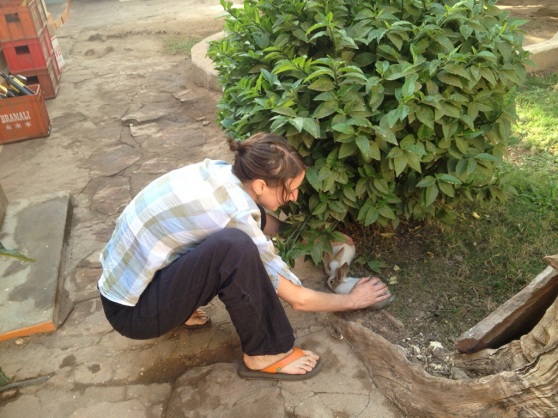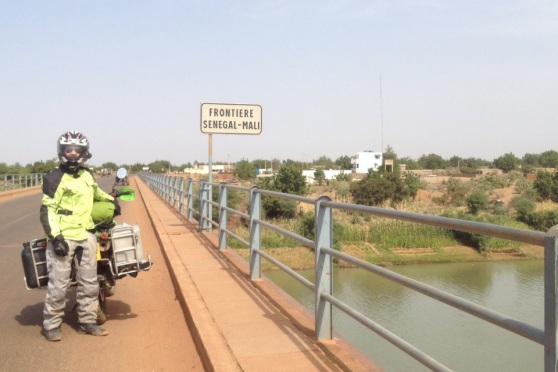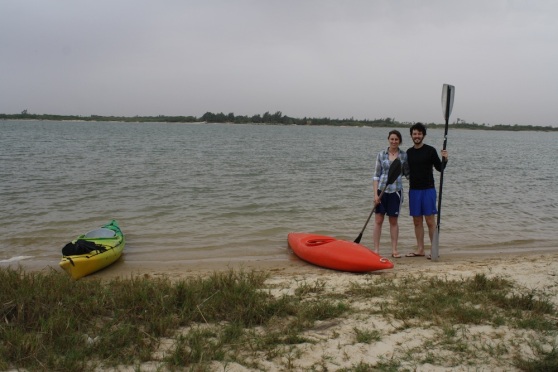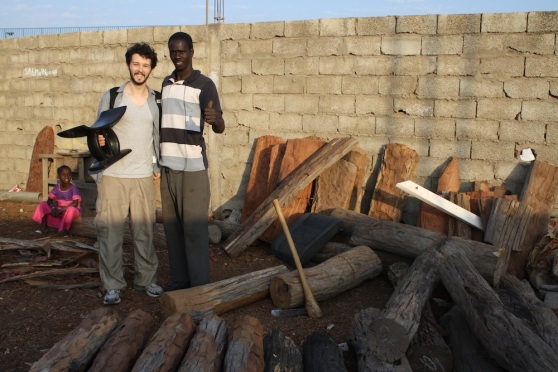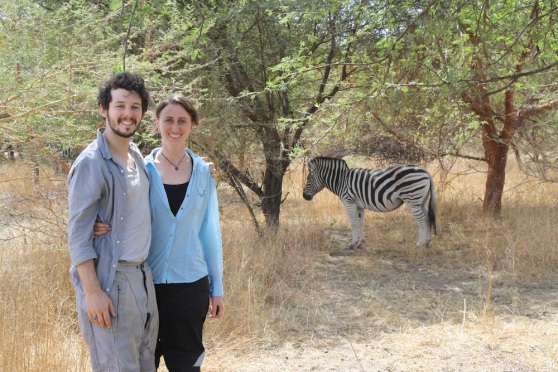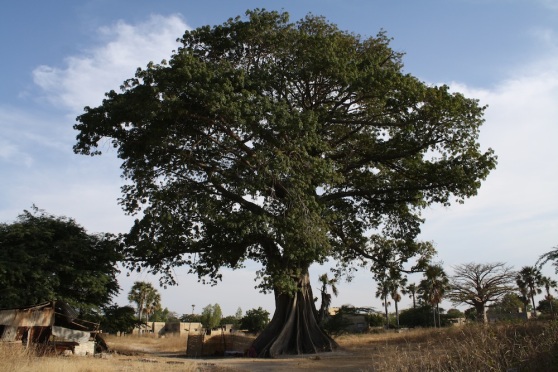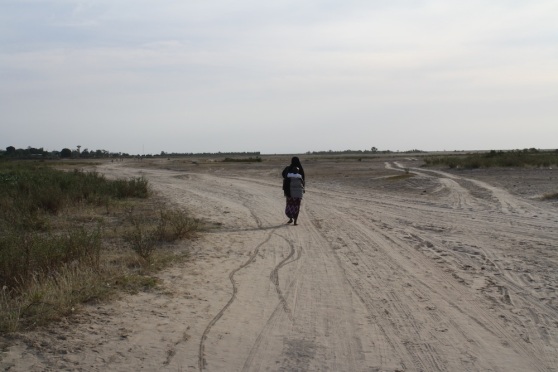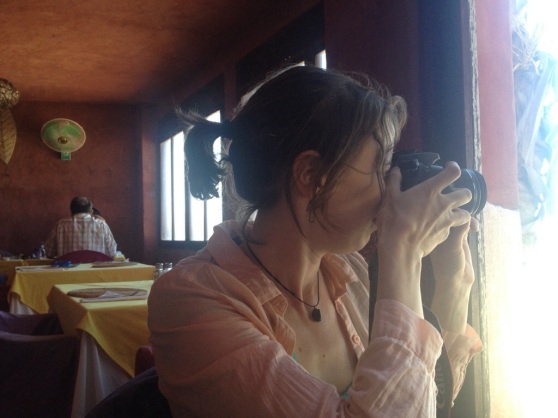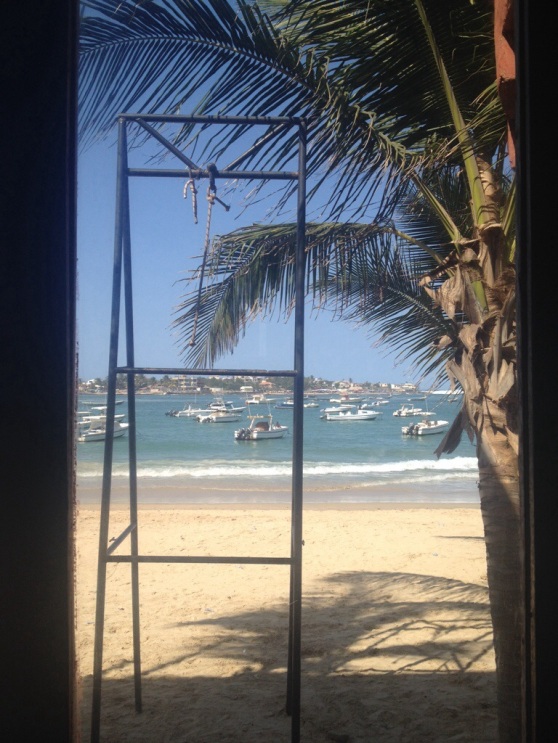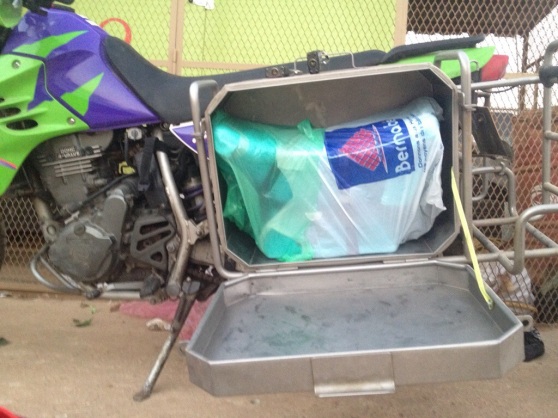We’re home. We’ve actually been here since Sunday night, but jey lag and attempting to catch up on life here has kept us from posting. Some more catch up posts should come before we forget everything that we did.
Burkina Faso in summary
Another delayed blog post (being finished in the Accra airport just before our flight home). Sorry.
We arrived in Burkina Faso from Mali. The border crossing went relatively well. First we visited immigration, where the immigration officer, “Pastor” Daniel, stamped our passports, gave us his phone number in case of any trouble and told us, “Welcome to Burkina Faso. It’s very safe. There is no Al-Queda here!” We then visited customs to purchase a laissez-passer, which was well marked (prices and all) and only took about 5 minutes to get (much better than the hour and a half it took in Mali).
We rode on to Banfora, which is a town surrounded by a bunch of really nice natural sites. We checked out:
- The Cascades at Karfiguela, some waterfalls 15km from town.
- Lake Tangrela, where we hired a canoe guide to show us the hippos (he also made a nice water lily necklace and crown).
- Our day trip to the previously mentioned Sindou Peaks.
and
We spent three nights in Banfora and a huge amount of time trying to get online. We got a ton of help from Jackie’s brother Bryan, who sent us systematically collected screen shots of satellite images of all our potential routes to the border with Ghana in order for to evaluate the state of the paved and dirt roads.
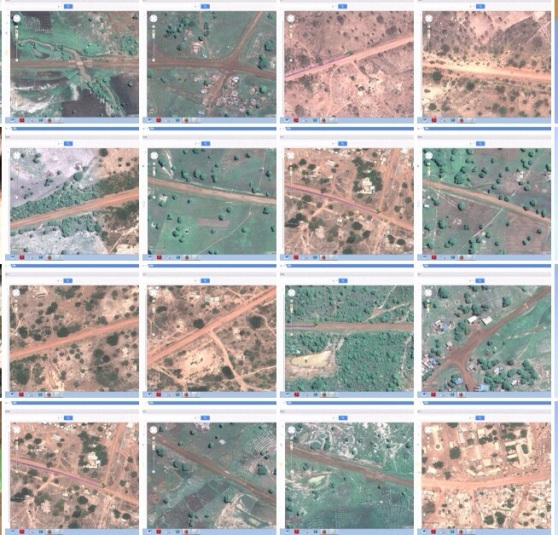
Right when we had finally downloaded the pictures, we got an email (part coincidence and part because we finally had a good enough connection to download and check email) from Jackie’s friend Claire in Ouagadougou who said we could spend the next night with her, thereby setting our route for us as the one with longer distances, but paved roads.
On our way to Ouagadougou, we did a quick drive by tourist viewing of the Great Mosque in Bobo-Dioulasso.
Claire was a gracious host who shared her huge house with us including the guest room, garage, and hot shower. She also made us a baked vegetable dish, which was a welcome change from all the fried food we had been eating.
The next morning we headed off to the Ghanaian border. Our time in Burkina was short, but we saw some beautiful places and met some very friendly people.
Parked in Accra!
Denmark to Ghana? Check!
We made it to Ghana! This is actually our fourth night is Ghana, but we’ve been staying with people we know or friends of friends in villages and internet has been really slow.
Sindou Peaks in Burkina Faso
10.65670°, -5.15317°
Here are a couple pictures from from the Sindou Peaks in South West Burkina Faso. It’s probably the coolest natural site we’ve seen on the trip.
It’s our last night in Burkina Faso and we will get a summary post up soon. Burkina Faso is green and beautiful, has great natural sites, and has terrible internet (at least in and around Banfora, where we spent most of our time).
From our time in and around Bamako
Another catch up post in mostly pictures and short summaries.
*** ROAD TO BAMAKO ***
A village on our route to Bamako (from Keyes). We liked this village because it looked like a maze of mud buildings.
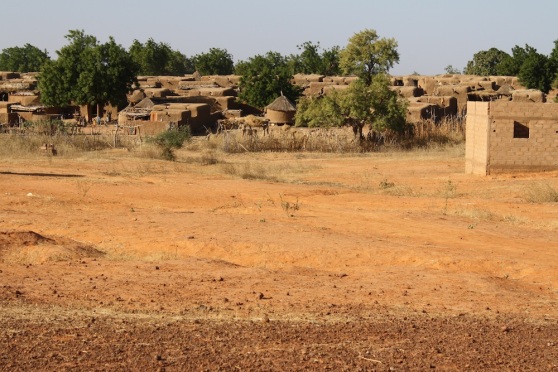
*** NIGER RIVER IN BAMAKO ***
In many growing cities around the world, the bodies of water that are in or pass through the city are disgusting (true of developing and developed countries). But the Niger River that flowed through the center of Bamako was surprisingly clean and beautiful. Maybe it’s because the rainy season just passed, but we really enjoyed crossing the long bridges that spanned this river in the middle of the city (and where we stayed happened to be right after one of the bridges, very close to the water).

View from the end of the street where we were staying.

*** THE SLEEPING CAMEL ***
When we were at Zebrabar in Saint-Louis, Senegal, we met a crazy Italian motorcyclist. He was one of the strongest advocates for going through Mali instead of northern Guinea and Cote D’Ivoire, and he told us about The Sleeping Camel in Bamako. We stayed there for 5 nights, and it was great. We hung out with Matt, the owner, a bit (but he never gave Jackie the Sleeping Camel billiards/pool champion T-shirt he promised her after losing a best of three contest), and got lots of good travel tips from him and all of the staff. There were also a few people that regularly hung around, and it was a great social atmosphere. Plus, there was very reasonably priced laundry (!), a good menu, and bunnies! We became a bit attached to the bunnies.
We also met another motorcyclist who was traveling overland. A Dutch guy, who seemed to have overland travel down to an art (the stickers on his bike and cases show that he’s been all over Africa, Europe, and into Siberia, multiple times). We wanted to learn more about his travels, but unfortunately he didn’t really speak any English, which seemed surprising from a) a Dutch person, and b) someone who’d travelled through that many places. Alas.
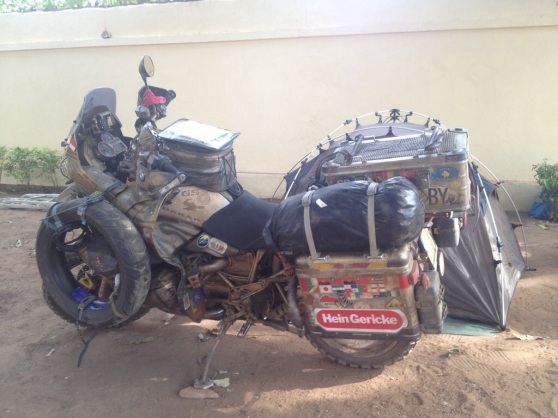
*** IN THE MARKET ***
Per the suggestions of everyone we met at the Sleeping Camel and the wonderful Sophie (a friend of a friend who used to live in Bamako and gave us a great list of things to do in record time), we visited the main market and the Maison des Artisans on our first day in the city.
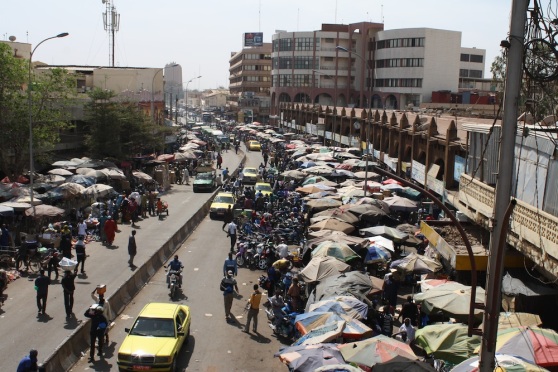
Mali is overflowing with KTM Power K scooters, a Chinese knock-off of a Honda from 1995 (and not actually from the Austrian KTM motorcycle manufacturer). We really couldn’t believe how everyone had the exact same scooter.
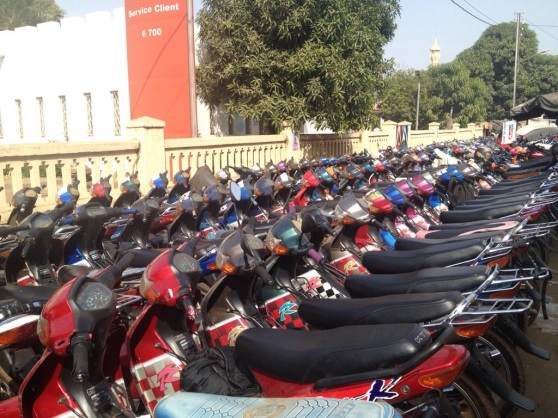
We then visited the Maison des Artisans, where we looked for a small bag/purse for Jackie (who’s been looking for one for when she has to dress up, which is becoming more often now that a bunch of her friends have been getting married). We didn’t see one that we liked immediately. But Aron had spotted a pattern he liked a lot, and Jackie saw a size she liked, and so we asked if they could custom make a bag in 48 hours. The Maison des Artisans was filled with people working on their crafts, and so they said it could easily be done. We discussed all the details of what the bag would look like, and then gave a down payment for the work.
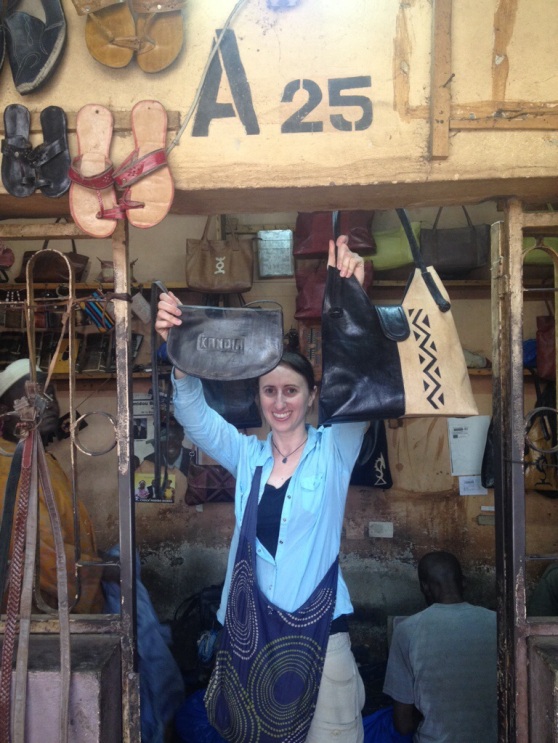
Two days later, we returned to find exactly the bag we wanted. The strap was a bit too long, and so the man who made the bag made a new strap in about 15 minutes, and we got to watch him finish the work.
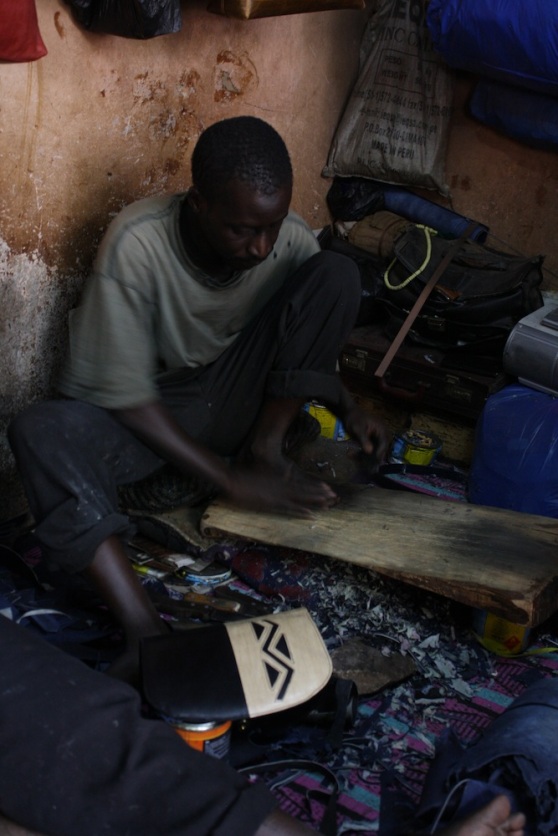
Oh, and while in the market, we found bottle-shaped water sachets. Aron thought these were pretty cool (and it was his first time drinking a water sachet).
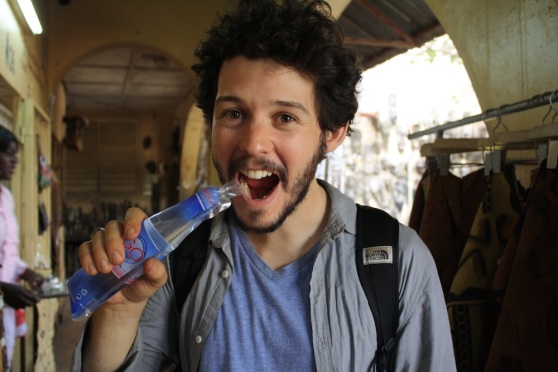
We also visited the national park, which was nice and tranquil, and we went out a couple nights to see the local restaurant/club scene.
*** MALIAN DANCE ***
Sophie put us in touch with a friend of hers, Djibi, who dances at the Yeredon Centre for the Arts. He invited us to one of his practices, and so we drove a bit out of town to watch. We had a great time watching the dancing. It was very similar to the type of dancing that Jackie did in college, when she danced in a group called PADAME (the Pan-African Drumming and Dancing Ensemble). It turns out that the main choreographer of PADAME, Joh, was a part of Yeredon (possibly in starting it? we didn’t fully understand the explanation in French), and Djibi and the others knew him well.
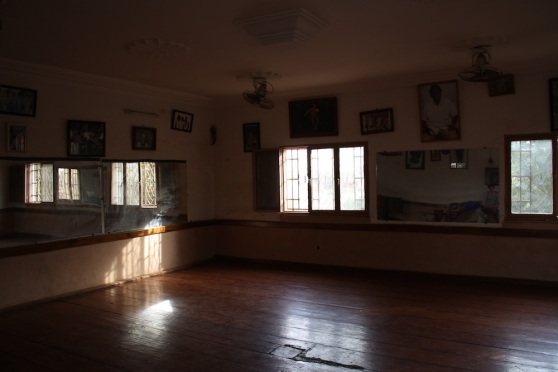
*** DAY TRIP TO SIBY ***
One our final day in Bamako, we took a day trip to the Siby (suggested by Matt at the Sleeping Camel). It was a beautiful ride to Siby, and we took the smaller road to get there. We ended up riding on 19km of dirt road to get back to the main road and to the town, and that’s where we found this awesome blue Citroen 2CV (abandoned and complete with flat tire). Note that we both really want a 2CV someday.
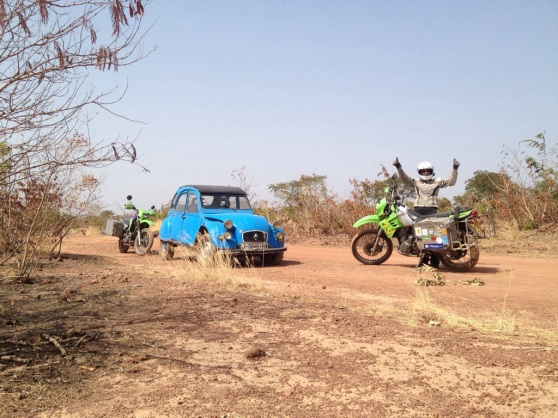
When we got Siby, we drove through town and found the stone arch. We took a small road that didn’t look like it’s traveled very often to get as close to the arch as possible. We then attempted to hike up the mountain on a path that looks like it’s only used by locals collecting firewood, and eventually disappears. We got close enough for some good pictures, though, and didn’t get hassled by anyone trying to be our guide.

When we drove back through town, we found the real road that leads to the arch, and also to a nice waterfall if you continue for 19km. Oops. Next time!
Route change update: We’re in Mali!
This post comes to you from Bamako, Mali. If you’ve been following this blog for a while, this might come as a surprise because Mali was not on our route. We didn’t have visas for Mali. We never bought a map of Mali. We weren’t going to Mali.
We seriously started planning our route for this trip about two years ago. There were two big contributors to how we planned our route at the time. One was that we learned that the summer (when we were originally traveling until Jackie’s accident) was the rainy season so we needed to stay away from the coast lest we get mired in mud, literally. That put the route through Sierra Leone and Liberia out of the picture. The other thing that happened in January 2012 is that Tuareg rebels started a rebellion in Northern Mali, eventually resulting in a coupe that ousted the Malian president and left Al-Qaeda affiliated rebel groups filling in the vacuum and taking control in the north of the country. This meant that we couldn’t go through Mali either, much to Jackie’s disappointment.
That was all ok, though. We set our course through Guinea and Côte d’Ivoire and that was our plan until a couple days ago. Thursday night, we sat down on our last night in Senegal to plan our route in Guinea for the next morning. We knew that roads weren’t supposed to be good, but some examination of Google Earth showed us we were headed for several hundred miles of dirt roads through remote mountains. And that was just days one and two of Guinea. Côte d’Ivoire didn’t look much better, so we made a game night decision and headed for the Mali border. Ever since we got back on this trip in mid-December, everyone we’ve met, both African and European has assumed our route was taking us through Mali. When we told them we were going through Guinea and Côte d’Ivoire they’ve been confused. Everyone wanted to know why we weren’t going through Mali. Mali has been quiet for the last 6 to 12 months, so we went for it.
We’re happy with the new plan. The roads through Mali have been great, Bamako seems like a cool city, and the people have been really friendly. We’re still not going through the North for safety reasons, but our new route brings us right to the part of Burkina Faso where we’ve gotten a bunch of recommendations. Plus, we’re shaving off about 1,000km of riding, which should let us enjoy more time in Ghana with people we know.
More pictures from Senegal
Senegal in (inadequate) summary
We just spent what is planned to be our last night in Senegal. We realize that we’ve been a bit negligent with blog posts but hopefully you’ve all been too preoccupied with the holidays to have noticed. In order to make up for the impression of Senegal you may have based on only stories of harried border crossings and ferries run aground, we present you with the highlights of our time here in list form:
- The main roads in Senegal have generally ranged from good to excellent. This is especially true the roads from the north border down past Dakar and until our ferry to Foundiougne. Starting from Foundiougne to Kaolack to Tambacounda we’ve hit patches of dirt road (that looked like it was being prepared for paving), areas where giant potholes appear with slalom-able frequency, and a few stretches of pothole fields where weaving left and right across both lanes or standing on the pegs and sucking it up were the only ways to go. That said, most of the country has been navigable at 60mph+ (100km/h+) and outside Dakar traffic has been pretty light.
- We spent Christmas Eve at ZebraBar, south of Saint-Louis, Senegal. It was a lovely dinner with a bunch of other overland travelers from Italy, Spain, and Switzerland. We relaxed and traded stories and traveling tips.
- Christmas day was spent hanging out, chasing birds that walked like tiny dinosaurs, kayaking, and running on an empty beach accessible only by boat. That night was spent with Jackie experiencing flu-like symptoms and 101.5°F (38.6°C) fever.
- We got on the road to Dakar in the morning with Jackie feeling better, full tanks of gas, and almost no cash. With only about $20 on us, we decided to skip the toll road into Dakar. This meant that we sat in two hours of traffic getting into the city, but we got to see the street vendors, people hopping on and off on minibuses, and life on the outskirts of town. (We took the toll road out of the city. It was cheap and really nice.)
- In Dakar we followed excellent recommendations given to us by our Senegalese friend, Aminata. We walked out to the Westernmost tip of all of Africa and then took a short taxi ride to our lunch spot for the day and one of Aminata’s best recommendations. We ate at La Cabane du Pecheur situated on the water across from Ngor Island. Those of you who know Aron know that he doesn’t eat seafood, but the meal was so fresh and well prepared that he broke down and just enjoyed the excellent food.
- After lunch came a trip to Gorée Island which was one of the smaller ports of departure for the slave boats that headed towards the Americas. While waiting for the boat we met Kane and Abdel, a Dakar local and his cousin who moved to the US at the age of seven and is now a college football player and CS student at Ohio State. Abdel heard our American accents and responded with his own American accented question asking where we were from. We talked to two of them on the boat and then Kane conducted our tour of the island. We also met up with him for dinner last night in Tambacounda where we were staying and where he is living and working as a doctor.
- We bought a small, hand carved wooden chair, the “petit chaise”. We usually have different styles and we both liked this chair. It cost about $30 and we got to see where the guys on the street were hand carving them. Our intent was to ship it home. We tracked down the DHL office and brought our “chaise” there only to find out that it would cost $250 to ship it home. The “petit chaise” is now in Aron’s motorcycle case for another 2,000 miles or so of traveling through Africa and will be one of our carry on “bags” for the flight home.
- After Dakar we met up with Aminata, her sister, husband, and friends at her family’s beach house outside Saly, Senegal. They all left after we had lunch together, but we stayed and spent the day swimming in the ocean, doing an oil change on the bikes and resting. We were really happy to be outside Saly in “our” private villa. (Note: Saly, which is a pretty small town, has its French Consulate due to the huge numbers of French expats there. We probably saw more white French people in Saly than we did in Paris last summer.)
- We did a two hour mini safari in the Bandia Animal Reserve, where they bring animals from other parts of Africa, but we got to see antelopes, water buffalo, giraffes, rhinos, and zebras.
- Then we headed for Foundiougne, where our ferry across the Saloum River got stuck in the sand (blogged previously), where we spent New Years Eve, and where Jackie got taken out by food poisoning for about 30 hours. With an unplanned recovery day behind us, we got to Tambacounda last night.
Rosso Border Crossing: the hellhole everyone says it is
We’ve posted about No Man’s Land between Moroccan controlled Western Sahara and Mauritania. While the process was lengthy and convoluted, the crossing was easier that we expected. Having made it through, our next crossing was a similarly dreaded crossing from Mauritania into Senegal. It was the only other part of this trip we’ve been really concerned about. Since we generally enjoyed our short time in Mauritania and Senegal has been great, keep in mind that this post represents the exception on our trip so far.
In short, we found The Rosso border crossing lived up to it’s terrible reputation.
Some takeaways:
1. If you don’t get a receipt it’s not real (this doesn’t mean you won’t have to pay, because receipts generally come after you’ve handed over your money).
2. Don’t let anyone without a uniform or not behind a desk hold your passport or paperwork (this is harder than it sounds).
3. Get through and get over it. Rosso is the toilet of West Africa, but the rest of Senegal is lovely.
In long…
There are two border crossing options between Mauritania and Senegal. They are Rosso and Diama. On the travelers forums we’ve read, Rooso is widely regarded as “the most corrupt border crossing in Africa.” Mind you that evaluation comes from people who have crossed lots of African borders, don’t through around a statement like that lightly, and know from experience. Rosso is swarmed by people who call themselves “helpers,” are call “touts” on the forums, but should be more accurately described as scammers, cheats, and assholes. Diama is a much smaller border crossing, accessible only by 50 miles of piste (dirt road), but also crosses you into Senegal right near St. Louis, which was our next stop. We could start to tell something was fishy within 100 miles of the border. The police checkpoints stopped being short exchanges of pertinent information (where are you from, what is your profession, where are you coming from/going to?), and started to become awkward conversations. Strategically, Jackie stopped speaking any French and Aron got to drive the conversations including one where a policeman placed a call and gave him his mobile phone in order to talk to a “friend” who spoke English (only marginally and who couldn’t really be heard anyway with a phone shoved in the side of a motorcycle helmet). This “friend” could supposedly meet us at the border to “help” us get through. Playing dumb and ignoring it seemed to work, but only after several minutes of “What? I can’t hear you.” Police started asking us if we were crossing at Rosso (easy to get to, but corrupt) or Diama (far flung, but supposedly better). At the first checkpoint we said Diama. Truthfully we weren’t sure which we’d do. At the second we said Rosso and the cop kept asking the question until we switched the Diama. This game played out a few times and it felt like we were being steered one way other the other, but it wasn’t clear which.
The turnoff for Diama is right in town in Rosso, only a couple hundred meters from the Rosso ferry. About 10 miles away we decided to go Diama. Somewhere around this point, a rundown black Mercedes started driving really close behind us. Annoyed, we pulled over to look at maps on our phones and let the car pass. The POS Mercedes loops around to follow us again. We speed up, it speeds up. We slow down, it slows down, now driving in front of us on the poorly paved road making it hard to see ahead and control our pace. We were in a populated area, so this wasn’t really threatening as much as irritating. We pull over at a gas station to fill up our tanks from our gas cans and to try to get rid of them again and the Mercedes stops down the road. Some guys get out saying they can “help” us at the border. We tell them we don’t want their help and they didn’t get the message until Jackie started yelling at them to get the hell away from us (or however close she could get to at in French).
At this point, another car pulled up, but these people seemed to be traveling towards the border themselves. They said they were going to Rosso, we said we’re going to Diama, and they pointed us in the direction of the turnoff. They also pointed out (for the second time we heard this) that you can’t get road insurance in Diama, so we should get it here in Rosso. They suggested that if we ride two motorcycles any closer than the turnoff to Diama, we’ll get swamped by touts, so Jackie went into town with one of the guys to buy insurance while Aron waited with one of the other guys at the turnoff with the bikes. Jackie frustratingly ended up going to three insurance places before finding one that would sell what we needed for Senegal (and supposedly for all of West Africa) it cost about 100Euros for a month which seemed high, but was also about the same amount we had paid for insurance at the border in Morocco (there was however no receipt). Aron waited awkwardly by the bikes for almost an hour.
At about 2:00pm with insurance in hand, we set off for Diama. At first the road was good, but it kept getting rougher and sandier. To keep this part of the story short, we made it about 15 miles in an hour before we decided to turn around and go back to Rosso. It didn’t seem worth risking an increasingly difficult road that looked like it would take at least two more hours to traverse to get to the slightly less corrupt border crossing.
At around 4:00 we made it back to Rosso and surprisingly the guy who helped us with insurance, Mangane or some name like that, hadn’t crossed to Senegal and was still hanging around at the border. He must not really have been traveling and Somehow he inserted himself as our “helper,” navigating the passport checks and customs paperwork on the Mauritania side of the river, which were relatively easy, but usually incorporated some sort of fee (with receipt). Jackie handled the paperwork, while Aron watched the bikes and ignored rude comments from the scammers who were growing tired of being systematically ignored (Note: these jerks need to work on their English language insults if they’re going to accomplish their goal of getting under your skin. “Your wife bad” just doesn’t cut it). General practice of the scammers is to hold on to you passports and paperwork between stops making it difficult to remove them from the equation.

We crossed the river to Senegal on one of the later ferries of the evening. The ferry is pretty crappy and so are the docks on both sides, requiring you to drive through 10 feet of shin deep water to get on and off. Mangane rushed us on saying it was the last ferry (it wasn’t), and he had to get back to other side (potentially because he had a Chinese guy to scam who was still on the other side). Instead of being done with him, he called a friend who met us to “help” on the Senegal side. When the boat stopped on the Senegal side, the shout-y border official took our passports and drivers licenses (something that requires digging in bags and pockets with both hands, while yelling at us to get off of the boat. Then he disappeared with the paperwork.
The Senegal side was a whole new level of screwed up. Here, the biggest issue was that the border and customs officials didn’t really acknowledge you existence, instead directing all conversation through the scammers (who they were most likely in league with) and thereby further removing you from control in the situation. At this point in the process the scammers (including Mangane who somehow reappeared after our “last ferry of the evening”) count of fatigue setting in. We had all the correct paperwork (visas for Senegal, Carne de Passage for the bikes, insurance) and Jackie still spent an hour or more navigating the various rooms and getting paperwork stamped by dismissive officials. Aron got worried waiting at the bikes and eventually found Jackie. After getting a signal that she didn’t need help, he quickly left the room before the official saw him to avoid changing the dynamic. Ten or so minutes later, Jackie came out with stamped passports, filled out Carnes, and passavants (temporary vehicle permits, which we didn’t really need but paid for). Somewhere in this process, one of the scammers pocketed about 30 or 40Euros that he was supposed to exchange and we had no local currency.
This is when they started demanding 50Euros per bike in payment for their “free help,” but couldn’t explain what we were paying for. Jackie, run down from the previous two hours, didn’t know what to do. Aron asked her if we had all the paperwork we needed and she said we did. We had been parked in to our parking space by some asshole in uniform who was getting his car washed. On Aron’s suggestion, Jackie went to the exit gate to see if there was any reason we couldn’t leave. Aron found a way out of the parking space by backing up and driving around a van. After some angry words, we made a break for the exit gate. We had no local currency, but the guard accepted a slight overpayment of 5Euros to open the gate. Aron pulled his bike up to the gate with a lot of engine revving to get people to step back and get their hands off of our bikes, Jackie passages through, and with some more screaming engine noises we pulled away as someone on the busy road yelled, “Go away! Go away! You are free!” At this point it was twilight and we basically promised ourselves not to drive after dark on this trip. Richard Toll was the closest town and after about 10 miles on good roads and not many minutes after dark, we found a hotel for the night.
The next day (Christmas day), we left for ZebraBar, a camping and bungalow site south of St. Louis, which was our intended destination for the first night in Senegal. ZebraBar was pretty filled with overland travelers. We compared our insurance with some German guys in a sweet Toyota Land Cruiser and realized we hadn’t gotten the proper “Carte Bruin” insurance for all of West Africa. They asked us about our Carne. They had gone through Diama the someday we went through Rosso. They told us there were no scammers, but the border officials were plenty crooked and had refused to stamp their Carne, stating they didn’t have the facilities for it (Note: the facilities consist entirely of the red customs stamp they had used on the German guys’ passavant and a pen). When we got to Dakar a couple days later we found an office for the insurance company we had purchased from on the Mauritania side only to be told our insurance was counterfeit, lacking a hologram and the proper stamps. So much for that 100Euros, although our supposedly counterfeit insurance had already gotten us through one police stop in St. Louis. We bought real insurance with proper full West Africa coverage from another company and paid about 30Euros total.
Oh yeah. In case we didn’t sell Rosso as bad enough, there was also a dead body inside the gated Rosso immigration area. We each separately saw a guy in a yellow shirt laid out and face down in the sand. Someone told Jackie he was passed out drunk. Neither of us stared long enough to see if he was breathing, but both of us have our doubts.
